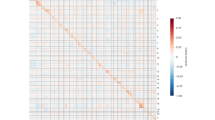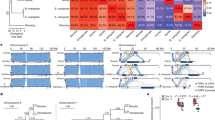Abstract
WITH ordered tetrads, such as occur in the asci of Neurospora crassa, the second-division meiotic spindles do not overlap (Fig. 1a) and the subsequent mitotic spindles are also well separated, with the result that analysis of the sequence of spores within the ascus allows a distinction to be made between first- and second-division segregation for a particular pair of alleles. With unordered tetrads, second-division segregation frequencies can be calculated from the frequencies of tetratype tetrads (for example, AB, ab, Ab, aB) for three independent loci, A/a, B/b and C/c, considered in pairs (A and B, B and C, C and A)1. When there is uncertainty whether the tetrads of a particular organism are ordered or not, use can be made of tetratype frequencies to estimate the frequencies of partial and complete spindle overlapping at the second division of meiosis. It is important to recognize such overlapping, since it may lead to inaccurate mapping of the centromeres, and, moreover, partial spindle overlap may mimic the effects of two-strand double cross-overs across the centromere. Thus the excess of such cross-overs found by Lindegren and Lindegren2 in N. crassa has been attributed3 to spindle overlapping, although there is good genetic evidence that such overlapping is not responsible4.
This is a preview of subscription content, access via your institution
Access options
Subscribe to this journal
Receive 51 print issues and online access
$199.00 per year
only $3.90 per issue
Buy this article
- Purchase on Springer Link
- Instant access to full article PDF
Prices may be subject to local taxes which are calculated during checkout
Similar content being viewed by others
References
Perkins, D. D., Genetics, 34, 607 (1949). Whitehouse, H. L. K., Nature, 165, 893 (1950).
Lindegren, C. C., and Lindegren, G., J. Hered., 28, 105 (1937); Genetics, 27, 1 (1942).
Newcombe, H. B., Genetics, 26, 128 (1941). Howe, H. B., ibid., 39, 972 (1954).
Whitehouse, H. L. K., New Phytol., 41, 23 (1942); Ph.D. thesis University of Cambridge (1948).
Boone, D. M., and Keitt, G. W., Amer. J. Bot., 43, 226 (1956).
Bistis, G., Bull. Torrey Bot. Cl., 83, 35 (1956).
Whitehouse, H. L. K., J. Genet. (in the press).
Author information
Authors and Affiliations
Rights and permissions
About this article
Cite this article
WHITEHOUSE, H. Use of Tetratype Frequencies for estimating Spindle Overlapping at the Second Division of Meiosis in ‘Ordered’ Tetrads. Nature 179, 162–163 (1957). https://doi.org/10.1038/179162a0
Issue Date:
DOI: https://doi.org/10.1038/179162a0
This article is cited by
-
Segregation of genes in Sordaria brevicollis
Genetica (1973)
-
Random segregation inNeurospora
Genetica (1965)
-
Crossover- und Chromatiden-Interferenz beiPodospora Anserina (CES.) Rehm
Zeitschrift für Vererbungslehre (1962)
Comments
By submitting a comment you agree to abide by our Terms and Community Guidelines. If you find something abusive or that does not comply with our terms or guidelines please flag it as inappropriate.



